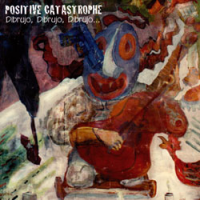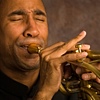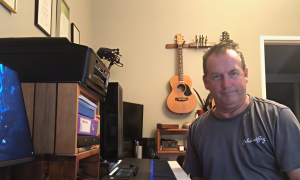Home » Jazz Articles » Take Five With... » Take Five With Steve Montgomery
Take Five With Steve Montgomery
In about 1980, I started to try to think about how to expand what the guitar could do harmonically and with its range (the bar has been set pretty high by all those great piano players out there). The two trend setters at the time (if you include jazz and rock) were Eddie Van Halen and Stanley Jordan, both of whom fretted the guitar with both hands at the same time. I wasn't looking for a rock sound, and I didn't really like the "pingy" tone that Jordan was getting. So, what I did was come up with a way to use both hands for chording, which gained greater options for chord voicings, but which didn't sacrifice a nice "round" jazz tone.
I was also able to find a way to play a number of chord clusters (which are not normally readily available to the shape of the hand and the tuning of the strings) along with a greatly "broadened" range from low to high pitch per guitar chord.
My blog includes the following: Explanatory Text, Feedback (John Scofield has some nice things to say), Chords and Chord Clusters categorized by scale "affiliation" (this section includes fingerings and MP3s), and Originals and Arrangements (this section includes fingerings, MP3s and, at times, notation on the staff).
I make this stuff available for free, but would be interested in feedback, dialogue, comments and ideas for application.
Instrument(s):
Guitar and bass
Teachers and/or influences?
I was lucky enough to take improvisation from Larry Slezak and Dennis Dotson. Larry was pushing me to use more intuition, and Dennis was more on the analytical side. What a great combination! Other than that, you learn from whoever you play with and from whoever you listen to.
I knew I wanted to be a musician when...
I heard The Beatles.
Your sound and approach to music:
I've been interested in writing and arranging for my method of two-hand chording lately. As far as an approach to music, I'd say anything goes if it sounds good to you.
Your teaching approach:
Start where they are, go where they want to go, be a good influence along the way.
Road story: Your best or worst experience:
A funny moment to me was playing guitar for a particular big band in the early '80s, when the bassist bet me that he would be able to put his bass down, leave, and return only at the end of the song, and that the band leader wouldn't even notice. I didn't think this was possible. I was proven wrong when I saw the bassist leaning against a column, smiling and waving, when he should have been playing a walking bass line. He barely made it back to his seat on the bandstand to see the leader give the "OK" sign to the band for sounding so good. This led to a few jokes about the value of this particular bassist and his contributions to the band.
The first Jazz album I bought was:
Wes Montgomery's A Day in the Life.
What do you think is the most important thing you are contributing musically?
A different sound to guitar chords due to the use of two-hand voicings, along with an eclectic use of varying musical sources for my arrangements and compositions (jazz standards, The Beatles, Alban Berg, ABBA, Sandi Patty, Charles Ives, lullabies, etc.)
CDs you are listening to now:
Pat Metheny, John Coltrane. Keith Jarrett, Stevie Wonder, Betty Carter.
What are some of the essential requirements to keep jazz alive and growing?
Be open-minded, play from the heart, play what you hear, hear what you play, listen to the wealth of good music that has been produced from the start until now.
What is in the near future?
I'm looking for dialogue, inspiration, exchange of ideas, etc. with other musicians about how to further apply and grow the two-hand chording technique I've developed.
By Day:
I teach 5th graders (all subject matter). After ten years, I still enjoy this. I find making lesson plans a lot like composing music and implementing lessons like improvising over changes. Through the course of the year, I incorporate the music of Coltrane, Frank Zappa, James Taylor, Billy Joel, Schoenberg and others into various assignments.
Tags
Steve Montgomery
Take Five With...
United States
Stanley Jordan
John Scofield
The Beatles
Wes Montgomery
pat metheny
John Coltrane
Keith Jarrett
Stevie Wonder
Betty Carter
Frank Zappa
James Taylor
PREVIOUS / NEXT
Support All About Jazz
 All About Jazz has been a pillar of jazz since 1995, championing it as an art form and, more importantly, supporting the musicians who make it. Our enduring commitment has made "AAJ" one of the most culturally important websites of its kind, read by hundreds of thousands of fans, musicians and industry figures every month.
All About Jazz has been a pillar of jazz since 1995, championing it as an art form and, more importantly, supporting the musicians who make it. Our enduring commitment has made "AAJ" one of the most culturally important websites of its kind, read by hundreds of thousands of fans, musicians and industry figures every month.





















